Transforming Places Into Experiences: Media Architecture Trends for 2020
ESI Design’s Head of Media Architecture, Emily Webster, shares four trends that are shaping our physical environment in 2020 for the better.
In 2020, people will expect more interesting public spaces. There is a buzz around public spaces that weave the physical and digital worlds together to create immersive experiences. But with technology being such an integral part of our lives, if we don’t curate the blend of the physical and digital intentionally, we will have poorly designed spaces crowded with advertising and 24-hour news feeds. Digital installations should be treated like an architectural material that needs to be thoughtful, well-designed, and purposeful. Fortunately, these types of thoughtfully designed spaces are showing up more and more thanks to an emerging practice called Media Architecture. Before we look at some of the emerging trends in Media Architecture, let’s define what it is.
Media Architecture combines the dynamism of digital installations with the placemaking of physical and architectural design. By integrating custom digital canvases and artistic audiovisual effects into walls and facades, media architecture enables static materials to tell stories. This union transforms how people connect with the space and with each other, producing a new kind of relationship between people and their environment.
As the Head of Media Architecture at ESI Design, I lead our team in thinking about new ways to tell our clients’ stories through large-scale media architecture projects. When including technology in a project, I start by understanding what the visitors should see and do along their journey, then define whether technology needs to be included. If there is a legitimate reason to include technology touch points, the next question is, “What’s the best technology for the given experience?” We treat dynamic digital components as another material in our architectural palette, alongside traditional material options. The “digital” is no different to us than flooring or lighting. It’s through the addition of the digital materials that we create buildings that then become flexible storytelling platforms. The end result is an experience that makes a space dynamic, exciting, and able to express a changing narrative, whether it’s a park, museum, corporate workplace, store, or other public place.
But we’ve all also seen bad examples of Media Architecture. These jarring installations, with TV screens seemingly stuck on a wall at random, projecting information and TV commercials at you, disorient visitors and disrupt the space. So, to help highlight what separates Media Architecture from the typical expectations for “digital,” I want to share five trends that are shaping the field in 2020 for the better.
TREND 1: Reactive and Motion-Activated Media Architecture
Reactive, motion-activated media architecture may be one of the fastest growing trends because of the way it can enhance the natural energy of a space. When these digital activations are able to reflect the movement of humans in a space, they deliver striking and unexpected experiences to passersby, employees, and the public.
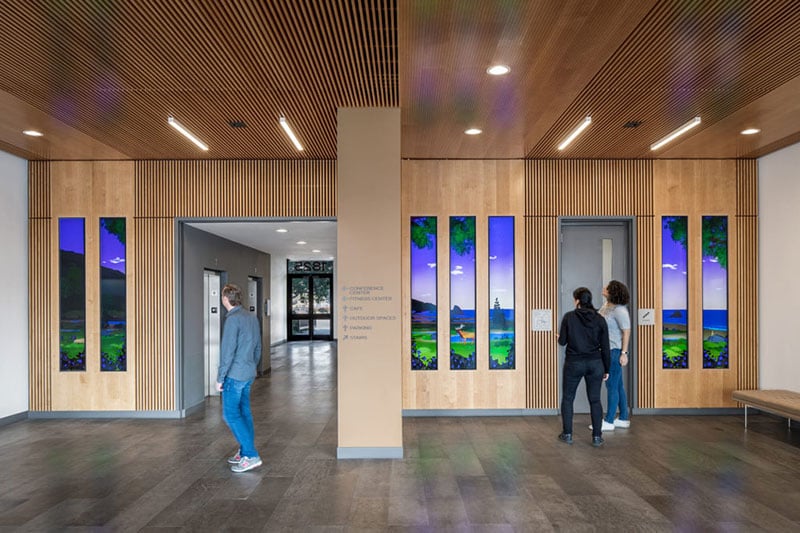 The Crossroads in San Mateo, CA
The Crossroads in San Mateo, CA
This effect is exemplified by the media at The Crossroads in San Mateo, California. In the lobby of The Crossroads’ office towers, digital panoramas of California landscapes are populated with plants and animals that react to visitors as they enter the building. Deer skitter away as people come through the front door, a bear might stare you down if you linger long enough, or flowers may bloom as they walk past the seven large-format panoramic LCD displays.
Similarly, in Washington, D.C.’s Terrell Place, a 1,700-square-foot LED mural features reactive animations of the city’s iconic cherry trees. As people pass by the mural, the cherry blossoms bud and bloom, and branches shake. Butterflies approach anyone who pauses in the lobby.
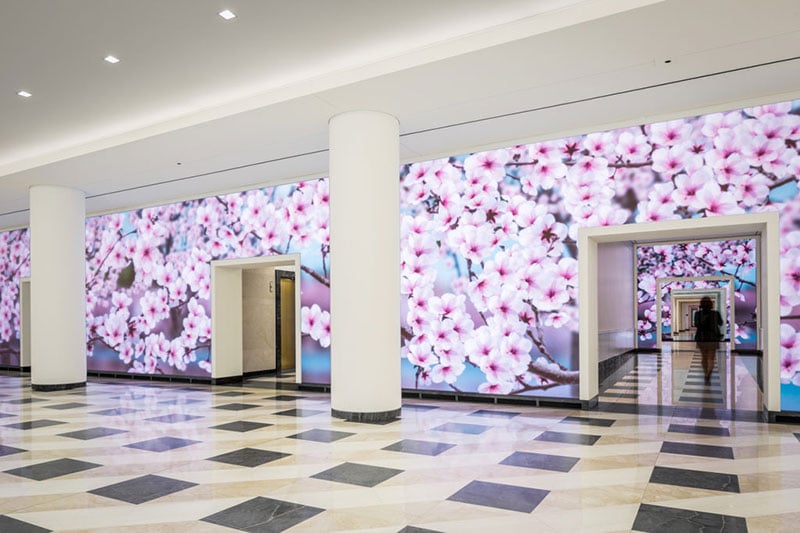 Terrell Place in Washington, D.C.
Terrell Place in Washington, D.C.
Reactive media also works for branding moments. For Nespresso, artist Daniel Rozin created a large circular sculpture with 832 motor-powered tiles decorated with recycled aluminum coffee pod lids that lift in response to passersby.
These types of reactive interventions allow a visitor’s movement through the building to be highlighted and rewarded, turning the mundane activity of entering their work place into an event that is worth acknowledging, and exemplifies how digital media can be site-specific and responsive to those who inhabit the building.
TREND 2: Interactive Media Architecture
Interactive media architecture takes the passive responses of reactive pieces to the next level, allowing users to access a wider array of responses or deeper levels of content. This kind of media architecture will be an important trend in 2020 because it facilitates the powerful, personal connections so important to employers, brands, and institutions.
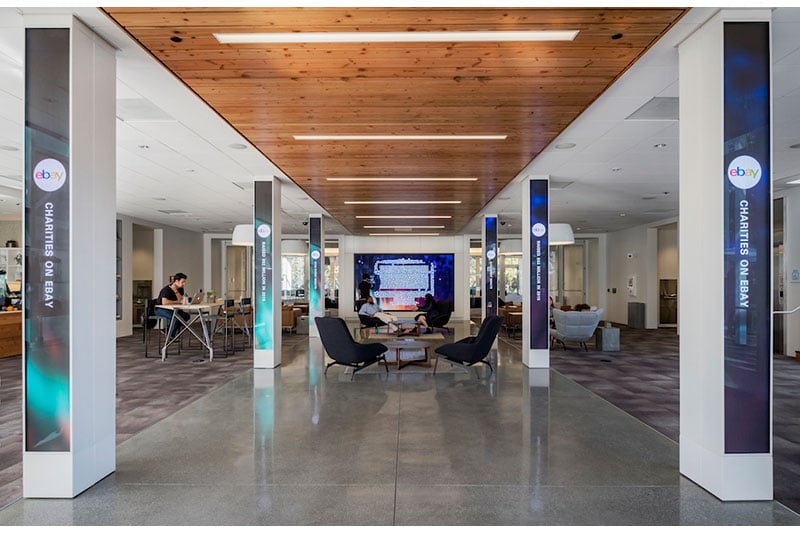 eBay Main Street in San Jose, CA
eBay Main Street in San Jose, CA
eBay’s Silicon Valley global headquarters hosts an exceptional example of this kind of media architecture in “Main Street,” its vibrant, 20,000-square-foot community hub. This interactive installation immerses visitors in a rich story about the company’s vast community of users and enormous volume of transactions. The centerpiece of Main Street is a 15-foot tall touchscreen wall that allows users to explore eBay’s most recent transactions. This combination of an information dashboard and a sales ticker lets employees see how the tools they build and the work they do affects real people’s lives. It offers a reminder that the world’s largest online marketplace isn’t just about sales.
New York City’s Statue of Liberty Museum, which opened in May 2019, uses media architecture to immerse visitors in the history, impact, and legacy of one of the world’s most iconic landmarks. A highlight of the museum is the Becoming Liberty interactive exhibit. At 10 double-sided interactive kiosks, visitors can reflect on and document their visit to the museum by taking a self-portrait and selecting which images depict their idea of Liberty from a collage of inspirational images These are added to an ever-growing digital mosaic spanning 40-feet that in real time displays data visualizations of how participants view liberty in the world today.
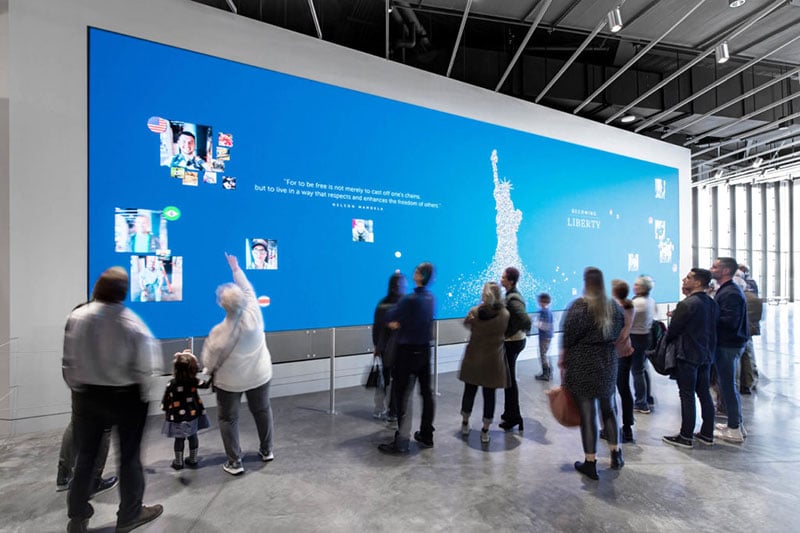 The Statue of Liberty Museum on Liberty Island in New York, NY
The Statue of Liberty Museum on Liberty Island in New York, NY
TREND 3: Data-Driven Media Architecture
We hear a lot of clients express how nervous they are about including digital components in their environments. They’re worried about the continual upkeep that they think is necessary to “feed the beast” that is an integrated digital platform. However, if you think about “content” as something that could be generative, and driven by real-time data you are suddenly unburdened by needing to continuously create pre-produced media content.
While reactive and interactive media amplifies the behavior of individuals in a building, data-driven media architecture enables the activation to resonate with the behavior of an entire institution. If you can identify datasets that are relevant to your client, and can use those data sets to create real time data visualizations that engage with your employees and visitors alike.
This approach takes the abstract essence of a brand or property, from company transactions (like the multitouch wall at eBay’s Silicon Valley HQ) to local weather to the daily ebb and flow of a building’s visitors, and transforms it into captivating visual stories that connect to everyone in a space.
The Tower at PNC Plaza in Pittsburgh provides a noteworthy example of this trend. One of the greenest high rises ever built, the Tower features a 24-foot-tall lobby installation called The Beacon. This chandelier-like sculpture translates real-time data from the building’s advanced green systems, as well as current environmental conditions like weather, building occupancy, and sunlight, into ever-changing light, color, text, and sound patterns.
Weather data also powers Sensing Change, a massive light-art installation that transformed an uninviting outdoor terrace in downtown Chicago into an urban oasis. Using the massive concrete wall of an adjacent parking garage as its expansive canvas, the piece translates real-time conditions into abstract light patterns which recall sunlight rippling through trees, rain falling, or clouds scudding across the sky.
In Los Angeles, the Walt Disney Concert Hall celebrated the 100th anniversary of the L.A. Philharmonic by visualizing music and sound. The Concert Hall tapped media artist Refik Anadol to transform the building’s façade with dazzling projections based on a century of the institution’s musical history. Working with the Artists and Machine Intelligence programs at Google Arts and Culture, Anadol mined the orchestra’s digital archives – almost 45 terabytes of data – to create algorithmic visualizations that mimic the process of human dreaming.
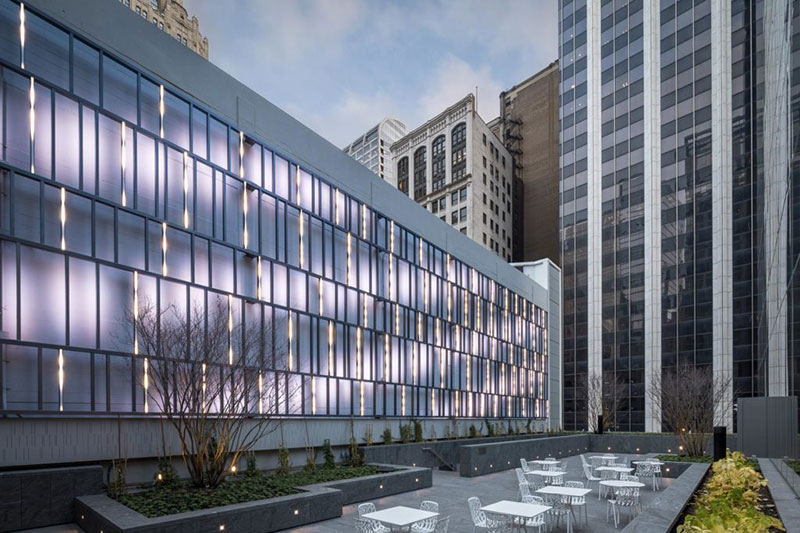 Sensing Change at 151 North Franklin Street in Chicago, IL
Sensing Change at 151 North Franklin Street in Chicago, IL
TREND 4: Custom, Epic-scale Media Architecture
To truly integrate media with architecture, displays need to move beyond the 16×9 screen format that is familiar from TVs and phones, and on to new, custom form factors designed specifically for each environment. This is where custom, epic-scale media architecture comes into play. Luckily, new technologies enable designers to work with increasingly unusual canvases and on an ever larger scale.
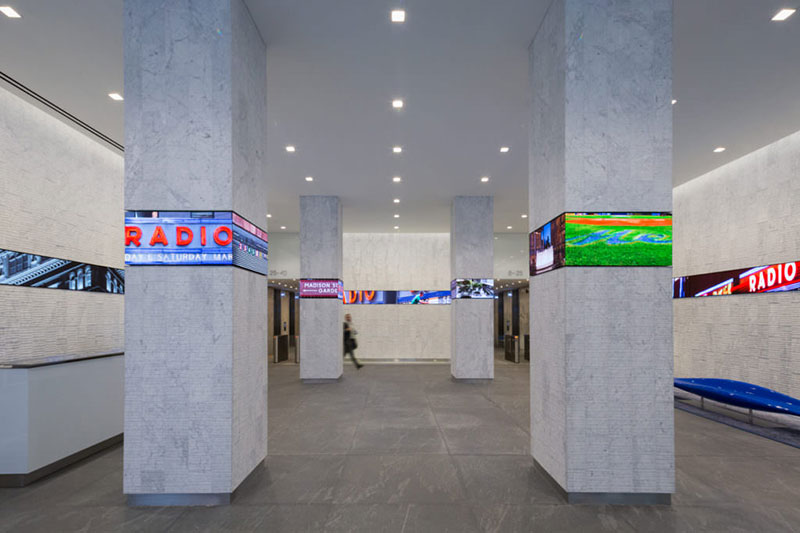 575 5th Avenue in New York, NY
575 5th Avenue in New York, NY
Unconfined by corners, the displays in the lobby of New York City’s 575 Fifth Avenue tightly wrap the walls and columns in the space. The ribbon of screens are finely architecturally integrated, and appears to tenants and visitors as a horizontal slice had been taken out of the building to “see” through the walls to the metropolis beyond.
In a shopping mall in Barcelona, Spain, shoppers are invited to “play” in and on an interactive tribute to mosaic art that features a 690-square-foot circular LED screen set in the central floor surrounded by a 223-foot-long screen suspended above it.
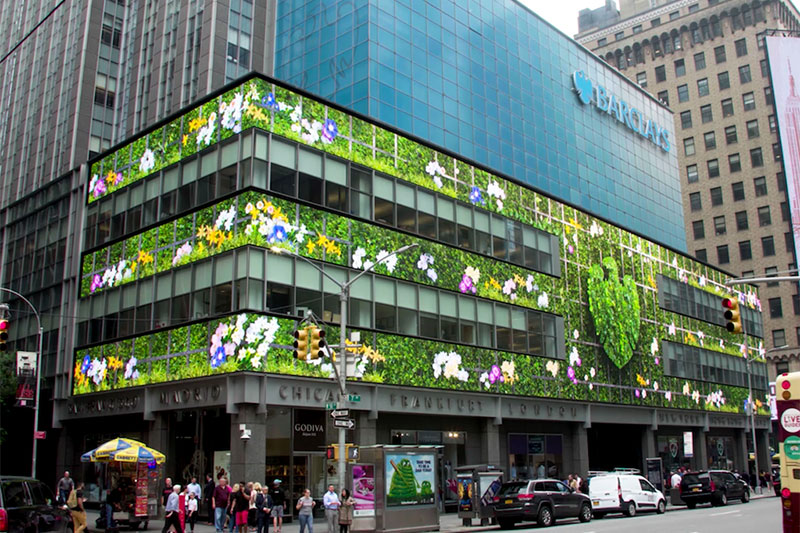 Barclays at 745 7th Avenue in New York, NY
Barclays at 745 7th Avenue in New York, NY
Barclays recently unveiled a larger-than-life physical example of their commitment to innovation – a new state-of-the-art digital signage installation on the façade of their Times Square headquarters. Totaling 7,046 square feet, the custom-designed and seamlessly integrated LED displays have become the digital face of Barclays in New York. The full-width of a New York city block, this epic-scale digital media experience stops passersby in their tracks using vibrant visuals and data-driven storytelling to communicate Barclays’ role in shaping the forward progress of business and society.
Most people think of digital technology as a flat surface, but what if it came to life in more an organic form? At The Central Standard Building in Chicago, the centerpiece of the expansive lobby is a curved LED ring. Levitating at the crossroads of the building’s multiple entrances, this digital activation is viewable from all directions and plays local data-driven content giving the piece a unique Chicago flair. The iconic media installation was custom-made for this public space and the circular LED display has an impressive 104-foot circumference.
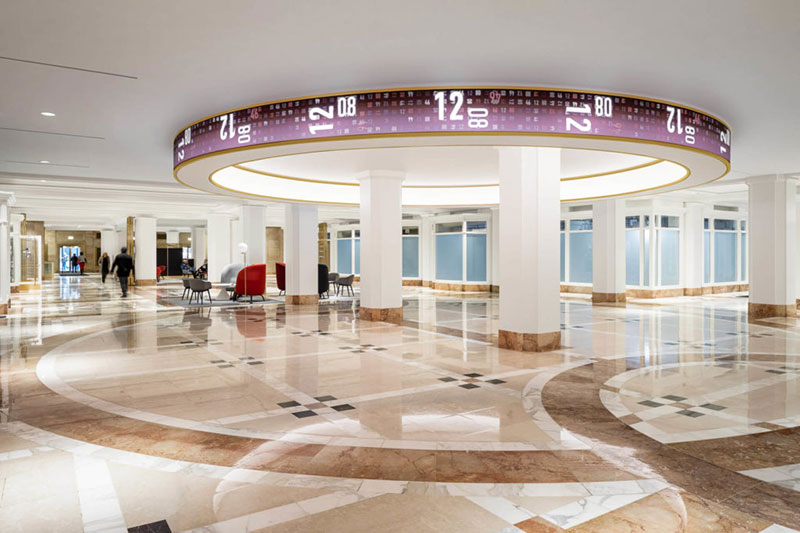 The Central Standard Building in Chicago, IL
The Central Standard Building in Chicago, IL
Final Thoughts
As digital media becomes increasingly ubiquitous in public spaces, it also becomes important for designers to use technology wisely. These media architecture trends reflect the wide variety of possibilities for integrating video, lighting, audio, and other dynamic technology into the built environment to foster a lively two-way relationship between a space and the people inhabiting it. The possibilities for using media architecture to create customized experiences will continue to expand beyond 2020 as sweeping technological advances continue to provide brands, retailers, developers and cultural institutions with exciting new ways to bring stories to life.
About Emily Webster
 Emily Webster, Head of Media Architecture - ESI Design
Emily Webster, Head of Media Architecture - ESI Design
At the helm of ESI’s pioneering media architecture practice, Emily Webster leads and innovates how ESI integrates technology into architecture. Bringing a strategic approach to the creative implementation of interactive A/V technologies, she helps our clients create engaging, meaningful experiences that elevate their brand or property within the marketplace. She views buildings as platforms that can adapt over time as the needs of the space or the business change.




